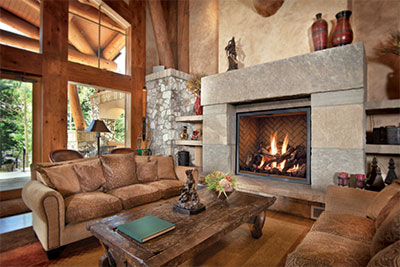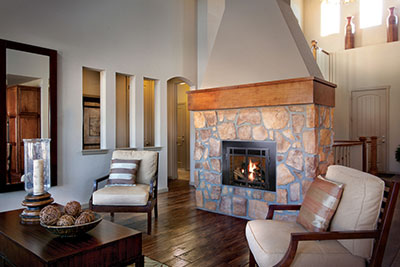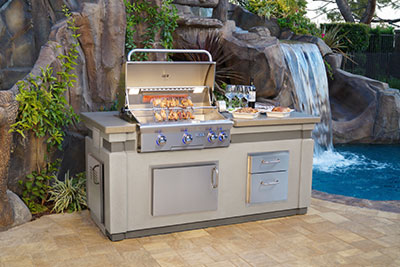Is it cheaper to run your furnace or my gas fireplace for heating the home?
That is a common question we get asked when customers are looking to save money on heating costs. Most people will think that a furnace is the most effective way to heat the home but it is most certainly not the case.
All gas appliances – furnaces, water heaters, as well as the gas stoves, fireplaces and inserts we sell — are given a BTU consumption rating by the manufacturer. This rating tells you how much gas that particular appliance burns per hour. If the flame height is adjustable, the rating will show two numbers: the amount of fuel consumption at the lowest setting, and the amount of fuel consumption at the highest setting. The BTU consumption rating for any gas appliance can be found in the owner’s manual or on the rating label, usually attached to the appliance.
Now, for comparison sake, let’s say your furnace, and your gas fireplace, are both rated at 30,000 BTU/hr. Since there are 100,000 BTU’s of heat value in one therm of natural gas, both appliances will consume one therm of natural gas every 3.3 hours when the burners are lit and the fireplace is adjusted to its highest flame setting.
It would seem at this point that these two heaters would consume exactly the same amount of gas to heat the same area, but this isn’t necessarily the case. We must also consider how many hours the burners in each of the two heaters will need to be lit each day to keep the living space at the desired temperature. One factor that determines this is extraction efficiency, which is a measurement of how effectively a given burner system extracts heat from the gas.
The other factor is delivery efficiency, which is a measurement of how effectively the extracted heat is delivered into the living space.
Furnace manufacturers list the extraction efficiency only. They really can’t list the delivered efficiency, as no two delivery systems (the ductwork or radiators that deliver the heat to the
house) are alike. The extraction efficiency rating is simply a measure of how well a particular furnace’s burner and plenum design turns burned gas into heat: for example, a 15-year-old gas furnace might have an extraction efficiency rating of, say, 75%, while a new Pulse furnace might have an extraction rating of 94% or more. Delivered efficiency is the unknown quantity with regards to furnace systems. Given all the variable factors in a furnace installation, such as heat loss per foot of ducting, it is very possible for a furnace with a 94% extraction rating to have an actual delivered efficiency of only 50% or so, depending upon the heat loss ratio of the ductwork or radiator system used to get the heat from the furnace into the living space.
Since the heat from a gas stove or fireplace is delivered directly into the living space without the need for air ducting or water piping, the testing laboratories are able to obtain a delivered efficiency rating. When you see an efflciency rating on a gas stove or fireplace, you’re not just being told how well the burners extract heat from gas: you’re being told how much of the heat produced is being delivered into your house.
There is a bit of math here to figure it out but its pretty simple so here is how you do it.
Take the BTU rating of the stove or fireplace you are considering and assume a 75% efficiency which is an average AFUE rating on heater rated gas appliances we sell. A Valor President, for example, has a range of 6400 to 20000 BTU’s. So when that unit is on high you’re getting 15000 BTU’s of delivered heat. A 40,000 BTU forced-air furnace (twice as big) with a burner efficiency of 94% might only be delivering 20,000 – 27,000 BTU/hr, depending upon how much heat is lost in the delivery system. To illustrate the difference, here’s something to try: next time your furnace is running, hold your hand directly over one of your heating registers and feel how cool the incoming air is after it has traveled through the duct system. Then, light up your fireplace and hold your hand the same distance from the viewing window. You’ll get an instant demonstration of the difference between duct heat delivery and direct delivery.
As you can see, whether your furnace will be cheaper or more expensive to operate will depend upon its BTU consumption rating, extraction efficiency rating, and the heat loss ratio of its delivery system. Since the most important of these factors, the heat loss ratio of the delivery system, is unique to your installation and impossible for you to measure accurately, the only way you’re ever really going to be sure which heater is more economical will be to pick two equally cold months and burn the fireplace exclusively for one month and the furnace for the other, then compare gas bills.
If we had to bet on which of the two systems will be less expensive to operate, we’d gamble on the gas fireplace. Today’s gas stoves and fireplaces have delivered efficiency ratings hovering around 70%, which would rival even a 98% efficient gas furnace with the best imaginable forced air delivery system. Also, much of the heat produced by a stove or fireplace is radiant heat, which is absorbed directly by the body and warms it much faster than the convected (heated air) heat produced by a forced air furnace. Another advantage is the ability to turn the stove or fireplace’s burners down, and “sip” gas to keep the temperature constant. This can be more economical than letting the living space cool until the thermostat lights up the furnace burners at full throttle to bring the house back up to temperature, in much the same way as freeway driving gives you better gas mileage than stop-and-go city driving. A final advantage to today’s gas stoves, fireplaces and inserts is the flame display. Our customers frequently report that the cheery flames just make them feel warmer, even when the burner is turned down to its lowest (and most economical) setting.
Warming Trends is your complete Fireplace and outdoor living resource. Contact Us if you have questions about how to better heat your home.







